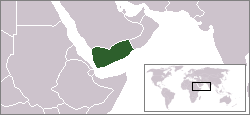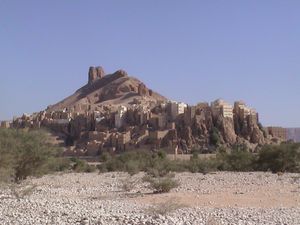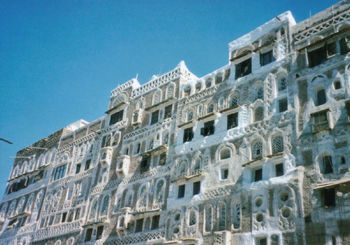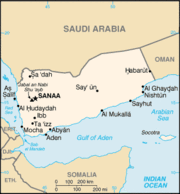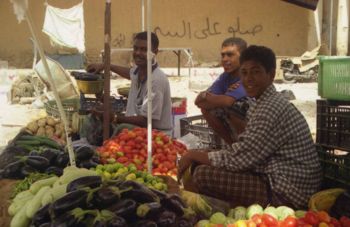Yemen
2007 Schools Wikipedia Selection. Related subjects: Countries; Middle Eastern Countries
| الجمهورية اليمنية Al-Ǧumhūriyyah al-Yamaniyyah Republic of Yemen |
|||||
|
|||||
| Motto: Allah, al-Watan, at-Thawra | |||||
| Anthem: United Republic | |||||
| Capital (and largest city) |
Sana'a |
||||
| Official languages | Arabic | ||||
|---|---|---|---|---|---|
| Government | Republic | ||||
| - President | Ali Abdullah Saleh | ||||
| - Prime Minister | Abdul Qadir Bajamal | ||||
| Establishment | |||||
| - Unification | May 22, 1990 | ||||
| Area | |||||
| - Total | 527,968 km² ( 49th) 203,849 sq mi |
||||
| - Water (%) | negligible | ||||
| Population | |||||
| - July 2005 estimate | 20,975,000 ( 51st) | ||||
| - Density | 40/km² ( 160th) 104/sq mi |
||||
| GDP ( PPP) | 2005 estimate | ||||
| - Total | $19.480 billion ( 110th) | ||||
| - Per capita | $751 ( 175th) | ||||
| HDI (2006) | |||||
| Currency | Yemeni rial ( YER) |
||||
| Time zone | ( UTC+3) | ||||
| - Summer ( DST) | ( UTC+4) | ||||
| Internet TLD | .ye | ||||
| Calling code | +967 | ||||
Yemen, officially the Republic of Yemen (Arabic: الجمهورية اليمنية ), is a Middle Eastern country located on the Arabian Peninsula in Southwest Asia. Yemen is composed of former North and South Yemen. It borders the Arabian Sea and Gulf of Aden on the south, the Red Sea on the west, Oman to the northeast and the rest of the country borders Saudi Arabia. Its territory includes the remote island of Socotra, about 350 kilometres (217 mi) to the south off the coast of East Africa.
History
Yemen is one of the oldest centers of civilization in the world. Between the ninth century BC and the sixth century AD, it was part of the Sabaean, Awsanian, Minaean, Qatabanian, Hadhramawtian, Himyarite, and some other kingdoms, which controlled the lucrative spice trade. It was known to the Romans as "Arabia Felix" ("Happy Arabia") because of the riches its trade generated. Augustus Caesar attempted to annex it, but the expedition failed. It was annexed by the Ethiopian Kingdom of Aksum around 520, and subsequently taken by the Sassanids around 570.
In the late sixth and early seventh centuries, many Sabaean people had continued to migrate from the land of Yemen following the destruction of the Ma'rib Dam (sadd Ma'rib) and became Bedouin. At this time when the Kingdom of Aksum did not have any intentions on keeping their ancient lush kingdom. That had become barren land from extending commerce trade of its lucrative spice trade with the Romans, Persian Sassanid kings. Yemen was successively incorporated into the Ethiopian and Persian Sassanid empires. In the 7th century, Islamic caliphs began to exert control over the area. After this caliphate broke up, the former North Yemen came under control of Imams of various dynasties usually of the Zaidi sect, who established a theocratic political structure that survived until modern times. (Imam is a religious term. The Shiites apply it to the prophet Muhammad's son-in-law Ali, his sons Hassan and Hussein, and subsequent lineal descendants, whom they consider to have been divinely ordained unclassified successors of the prophet.)
Egyptian Sunni Caliphs occupied much of North Yemen throughout the eleventh century. By the sixteenth century and again in the nineteenth century, north Yemen was part of the Ottoman Empire, and in some periods its Imams exerted control over south Yemen.
North Yemen became independent of the Ottoman Empire in 1918 and became a republic in 1962. In 1839, the British occupied the port of Aden and established it as a colony in September of that year. They also set up a zone of loose alliances (known as protectorates) around Aden to act as a protective buffer. In 1967, they withdrew following increasing pressure from local insurgency and Egyptian-sponsored attacks from the north. After the British withdrawal, this area became known as South Yemen. In 1970, the southern government adopted a communist governmental system. The two countries were formally united as the Republic of Yemen on May 22, 1990.
Politics
Yemen is a republic with a bicameral legislature. Under the constitution, an elected president, an elected 301-seat House of Representatives, and an appointed 111-member Shura Council share power. The president is head of state, and the prime minister is head of government. The constitution provides that the president be elected by popular vote from at least two candidates endorsed by Parliament; the prime minister is appointed by the president. The presidential term of office is seven years, and the parliamentary term of elected office is six years. Suffrage is universal over 18 years of age.
President Ali Abdullah Saleh became the first elected President in reunified Yemen in 1999 [though he had been President of unified Yemen since 1990 and President of North Yemen since 1978] and most recently was re-elected in September of 2006 after an initial reluctance to run once more. His victory was marked by an election that international observers judged to be "generally free and fair". Popular demonstrations and editorials of support in major papers helped change his mind to run again. In April 2003 parliamentary elections were held, and the General People's Congress (GPC) maintained an absolute majority. There was a marked decrease from previous years in election-related violence; however, there were some problems with underage voting, confiscation of ballot boxes, voter intimidation, and election-related violence.
The constitution calls for an independent judiciary. The former northern and southern legal codes have been unified. The legal system includes separate commercial courts and a Supreme Court based in Sanaá. Since the country is an Islamic state, the Islamic holy book, the Qur'an, is the basis for all laws, and no law may contradict the Qur'an. Indeed many court cases are debated by the religious basis of the laws i.e. by interpretations of the Qur'an. For this reason, many Judges are religious scholars as well as legal authorities. Unlike Saudi Arabia and other Islamic states, the consumption of alcohol by foreigners is tolerated, and the mild narcotic Qat is chewed by Yemenis of all strata of society, despite being banned or frowned upon by other Islamic countries and groups.
Administrative divisions
As of February 2004, Yemen is divided into twenty governorates and one municipality . The size of each governorate in terms of population is as follows:
|
|
|
|
|
21 divisions: 21,721,643 b
a capital (municipality); b approx.
Geography
Yemen is in the Middle East, in the south of Arabia, bordering the Arabian Sea, Gulf of Aden, and Red Sea, west of Oman and south of Saudi Arabia. It is considered to be one of the fifteen states that comprise the Cradle of Humanity.
The Red Sea islands: Hanish Islands, Kamaran and Perim as well as Socotra in the Arabian Sea belong to Yemen.
At 203,837 mi² (527,970 km²), Yemen is the world's 49th-largest country (after France). It is comparable in size to Thailand, and somewhat larger than the US state of California.
Until recently its northern border was undefined because the Arabian Desert prevented any human habitation there.
The country can be divided geographically into four main regions: the coastal plains in the west, the western highlands, the eastern highlands, and the Rub al Khali in the east.
The Tihamah ("hot lands") form a very arid and flat coastal plain. Despite the aridity, the presence of many lagoons makes this region very marshy and a suitable breeding ground for malarial mosquitoes. There are also extensive crescent-shaped sand dunes. The evaporation in the Tihama is so great that streams from the highlands never reach the sea, but they do contribute to extensive groundwater reserves; today these are heavily exploited for agricultural use.
The Tihamah ends abruptly at the escarpment of the western highlands. This area, now heavily terraced to meet the demand for food, receives the highest rainfall in Arabia, rapidly increasing from 100 mm (4 inches) per year to about 760 mm (30 inches) in Ta'izz and over 1,000 mm (40 inches) in Ibb. Agriculture here is very diverse, with such crops as sorghum dominating, but cotton and many fruit trees are also grown, with mangoes being the most valuable. Temperatures are hot in the day but fall dramatically at night. There are perennial streams in the highlands but these never reach the sea because of high evaporation in the Tihama.
The central highlands are an extensive high plateau over 2,000 metres (6,560 feet) in elevation. This area is drier than the western highlands because of rain-shadow influences, but still receives sufficient rain in wet years for extensive cropping. Diurnal temperature ranges are among the highest in the world: ranges from 30°C (86°F) in the day to 0°C (32°F) at night are normal. Water storage allows for irrigation and the growing of wheat and barley. Sana'a is located in this region. The highest point in Yemen is Jabal an Nabi Shu'aya, at 3,760 meters (12,336 ft).
The Rub al Khali in the East is much lower, generally below 1,000 metres, and receives almost no rain. It is populated only by Bedouin herders of camels.
Economy
In terms of GDP per capita, Yemen is the poorest country in the Arab world and one of the poorest nations in the world overall. Yemen is also the only country in Asia with a "low" Human Development Index. At unification, both the YAR and the PDRY were struggling, underdeveloped economies. In the north, disruptions of civil war (1962–1970) and frequent periods of drought had dealt severe blows to a previously prosperous agricultural sector. Coffee, formerly the north's main export and principal form of foreign exchange, declined as the cultivation of qat increased. Low domestic industrial output and a lack of raw materials made the YAR dependent on a wide variety of imports.
Remittances from Yemenis working abroad and foreign aid paid for perennial trade deficits. Substantial Yemeni communities exist in many countries of the world, including Yemen's immediate neighbors on the Arabian Peninsula, Indonesia, India, East Africa, and also the United Kingdom, and the United States. Beginning in the mid- 1950s, the Soviet Union and China provided large-scale assistance.
In the south, pre-independence economic activity was overwhelmingly concentrated in the port city of Aden. The seaborne transit trade, which the port relied upon, collapsed with the closure of the Suez Canal and Britain's withdrawal from Aden in 1967.
Since unification, the government has worked to integrate two relatively disparate economic systems. However, severe shocks, including the return in 1990 of approximately 850,000 Yemenis from the Gulf states, a subsequent major reduction of aid flows, and internal political disputes culminating in the 1994 civil war hampered economic growth. Yemen, the fastest growing democracy in the Middle East, is attempting to climb into the middle human development region through ongoing political and economic reform.
Since the conclusion of the war, the government entered into agreement with the International Monetary Fund (IMF) to implement a structural adjustment program. Phase one of the IMF program included major financial and monetary reforms, including floating the currency, reducing the budget deficit, and cutting subsidies. Phase two will address structural issues such as civil service reform. The World Bank also is active in Yemen, with twenty-two active projects in 2004, including projects to improve governance in the public sector, water, and education. Since 1998, the government of Yemen has sought to implement World Bank economic and fiscal recommendations. In subsequent years, Yemen has lowered its debt burden through Paris Club agreements and restructuring U.S. foreign debt. In 2003, government reserves reached $5 billion.
The main oil produced and used in Yemen is Marib oil. Marib oil contains associated natural gas. Proven reserves of 10 to 13 trillion cubic feet (283 to 368 km³) could sustain a liquid natural gas (LNG) export project.
Foreign relations
The geography and ruling Imams of North Yemen kept the country isolated from foreign influence before 1962. The country's relations with Saudi Arabia were defined by the Taif Agreement of 1934, which delineated the northernmost part of the border between the two kingdoms and set the framework for commercial and other intercourse. The Taif Agreement has been renewed periodically in 20-year increments, and its validity was reaffirmed in 1995. Relations with the British colonial authorities in Aden and the south were usually tense.
The Soviet and Chinese Aid Missions established in 1958 and 1959 were the first important non-Muslim presence in north Yemen. Following the September 1962 revolution, the Yemen Arab Republic became closely allied with and heavily dependent upon Egypt. Saudi Arabia aided the royalists in their attempt to defeat the Republicans and did not recognize the Yemen Arab Republic until 1970. Subsequently, Saudi Arabia provided Yemen substantial budgetary and project support. At the same time, Saudi Arabia maintained direct contact with Yemeni tribes, which sometimes strained its official relations with the Yemeni Government. Hundreds of thousands of Yemenis found employment in Saudi Arabia during the late 1970s and 1980s.
In February 1989, north Yemen joined Iraq, Jordan, and Egypt in forming the Arab Cooperation Council (ACC), an organization created partly in response to the founding of the Gulf Cooperation Council, and intended to foster closer economic cooperation and integration among its members. After unification, the Republic of Yemen was accepted as a member of the ACC in place of its YAR predecessor. In the wake of the Gulf crisis, the ACC has remained inactive. Yemen is not a member of the Gulf Cooperation Council.
British authorities left southern Yemen in November 1967 in the wake of an intense rebellion. The People's Democratic Republic of Yemen, the successor to British colonial rule, had diplomatic relations with many nations, but its major links were with the Soviet Union and other Marxist countries. Relations between it and the conservative Arab states of the Arabian Peninsula were strained. There were military clashes with Saudi Arabia in 1969 and 1973, and the PDRY provided active support for the Dhofar rebellion against the Sultanate of Oman. The PDRY was the only Arab state to vote against admitting new Arab states from the Persian Gulf area to the United Nations and the Arab League. The PDRY provided sanctuary and material support to various insurgent groups around the Middle East.
Yemen is a member of the United Nations, the Arab League, and the Organization of the Islamic Conference. Yemen participates in the nonaligned movement. The Republic of Yemen accepted responsibility for all treaties and debts of its predecessors, the YAR and the PDRY. Yemen has acceded to the nuclear nonproliferation treaty. The Gulf crisis dramatically affected Yemen's foreign relations. As a member of the UN Security Council (UNSC) for 1990 and 1991,Yemen abstained on a number of UNSC resolutions concerning Iraq and Kuwait and voted against the "use of force resolution." Western and Gulf Arab states reacted by curtailing or canceling aid programs and diplomatic contacts. At least 850,000 Yemenis returned from Saudi Arabia and the Gulf.
Subsequent to the liberation of Kuwait, Yemen continued to maintain high-level contacts with Iraq. This hampered its efforts to rejoin the Arab mainstream and to mend fences with its immediate neighbors. In 1993, Yemen launched an unsuccessful diplomatic offensive to restore relations with its Persian Gulf neighbors. Some of its aggrieved neighbors actively aided the south during the 1994 civil war. Since the end of that conflict, tangible progress has been made on the diplomatic front in restoring normal relations with Yemen's neighbors. The Omani-Yemeni border has been officially demarcated. In the summer of 2000, Yemen and Saudi Arabia signed an International Border Treaty settling a fifty year-old dispute over the location of the border between the two countries. Yemen settled its dispute with Eritrea over the Hanish Islands in 1998.
Demographics
Unlike most other people of the Arabian Peninsula who have historically been nomads or semi-nomads, Yemenis are almost entirely sedentary and live in small villages and towns scattered throughout the highlands and coastal regions.
Yemenis are divided into two principal Islamic religious groups: 42% Shi'a and 55% Sunni. This is broken up as: 30-35% of the Zaidi order of Shi'a Islam, 7-12% of the Ja'fari and Isma'ili orders of Shi'a Islam, and 55% of the Shafi'i order of Sunni Islam.
The Shi'is are predominantly in the north and northwest of Yemen whilst the Sunnis are predominantly in the south and southeast, although there are mixed communities in the larger cities. Most of the Yemenite Jews immigrated to Israel. The Yemenite Jews make up less than 1% of the population.
The Yemenite Jews once formed a sizeable Jewish minority in Yemen with a distinct culture. This community now consists of only a few hundred individuals, following the Jewish exodus from Arab lands and Operation Magic Carpet (Yemen).
Yemenis are mainly of Arab origin. Arabic is the official language, although English is increasingly understood by citizens in major cities. In the Mahra area (the extreme east) and the island Soqatra, several ancient south-Arabic languages are spoken. When the former states of north and south Yemen were established, most resident minority groups departed.
The country has one of the world's highest birth rates; the average Yemeni woman bears seven children. Although this is similar to the rate in Somalia to the south, it is roughly twice as high as that of Saudi Arabia and nearly three times as high as those in the more modernized Persian Gulf states.
Languages
While the national language is Arabic (spoken in several regional dialects), Yemen is one of the main homelands of the South Semitic family of languages, which includes the non-Arabic language of the ancient Sabaean Kingdom. Its modern Yemeni descendants are closely related to the modern Semitic languages of Eritrea (Tigrinya) and Ethiopia (Amharic). However, only a small remnant of those languages exists in modern Yemen, notably on the island of Socotra and in the back hills of the Hadhramaut coastal region. Modern South Arabian languages spoken in Yemen include Mehri, with 70,643 speakers, Soqotri, with an estimated 43,000 speakers (2004 census) mainly on the island of Socotra, and Bathari (with an estimated total of only 200 speakers).
English is taught as a foreign language in public schools from grade seven on, though the quality of public school instruction is low. Private schools using a British or American system teach English and produce the proficient speakers, but Arabic is the dominant language of communication. The number of English speakers in Yemen is small compared to other Arab countries such as Egypt, Lebanon, the UAE and Saudi Arabia.
Holidays
| Date | Holiday | Notes |
|---|---|---|
| January 1 | New Year's Day | |
| May 22 | National Unity | Celebrates the unification of the Republic of Yemen |
| September 26 | 1962 Revolution Day | Celebrates the revolution against the northern Imams |
| October 14 | 1967 Revolution Day | Celebrates the revolution against the British in the south |
| November 30 | Independence Day | Independence from the British |
Dates following the lunar Islamic calendar
| Date | Holiday/Festival |
|---|---|
| Dhul Hijjah 10 | Eid al-Adha |
| Shawwal 1 | Eid al-Fitr |
| Muharram 1 | (Islamic New Year) |
Geographic locale
 |
 |
|||
| Gulf of Aden |
Arabian Sea |
Afghanistan • Armenia • Azerbaijan 1 • Bahrain • Bangladesh • Bhutan • Brunei • Cambodia • People's Republic of China 2 • Cyprus • East Timor 3 • Georgia 1 • India • Indonesia 3 • Iran • Iraq • Israel • Japan • Jordan • Kazakhstan 1 • Kuwait • Kyrgyzstan • Laos • Lebanon • Malaysia • Maldives • Mongolia • Myanmar • Nepal • North Korea • Oman • Pakistan • Philippines • Qatar • Russia 1 • Saudi Arabia • Singapore • South Korea • Sri Lanka • Syria • Tajikistan • Thailand • Turkey 1 • Turkmenistan • United Arab Emirates • Uzbekistan • Vietnam • Yemen
For dependent and other territories, see Dependent territory and List of unrecognized countries.
1 Partly in Europe. 2 The Republic of China (Taiwan) not officially recognized by the United Nations; see Political status of Taiwan. 3 Partly or wholly reckoned in Oceania.
Eurasia: Bahrain • Bangladesh • Christmas Island • Cocos (Keeling) Islands • India • Indonesia • Iran • Iraq • Israel • Kuwait • Malaysia • Maldives • Myanmar • Oman • Pakistan • Qatar • Saudi Arabia • Sri Lanka • Thailand • United Arab Emirates • Yemen
Africa: Comoros • Djibouti • Eritrea • Kenya • Madagascar • Mauritius • Mayotte • Mozambique • Seychelles • Somalia • Somaliland • South Africa • Sudan • Tanzania
Oceania: Australia • Christmas Island • Cocos (Keeling) Islands
Islands: Bahrain • Christmas Island • Cocos (Keeling) Islands • Madagascar • Maldives • Mauritius • Mayotte • Seychelles • Sri Lanka
Afghanistan • Albania • Algeria • Azerbaijan • Bahrain • Bangladesh • Benin • Burkina Faso • Brunei • Cameroon • Chad • Comoros • Côte d'Ivoire • Djibouti • Egypt • Gabon • Gambia • Guinea • Guinea-Bissau • Guyana • Indonesia • Iran • Iraq • Jordan • Kuwait • Kazakhstan • Kyrgyzstan • Lebanon • Libya • Maldives • Malaysia • Mali • Mauritania • Morocco • Mozambique • Niger • Nigeria • Oman • Pakistan • State of Palestine • Qatar • Saudi Arabia • Senegal • Sierra Leone • Somalia • Sudan • Surinam • Syria • Tajikistan • Turkey • Tunisia • Togo • Turkmenistan • Uganda • Uzbekistan • United Arab Emirates • Yemen
Observer countries: Bosnia and Herzegovina • Central African Republic • Russia • Thailand • Turkish Republic of Northern Cyprus
Observer Muslim organizations and communities: Moro National Liberation Front
Observer international organizations: Economic Cooperation Organization • Organisation of African Unity • League of Arab States • Non-Aligned Movement • United Nations


